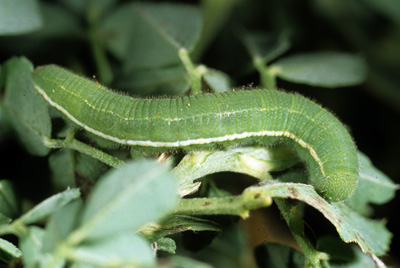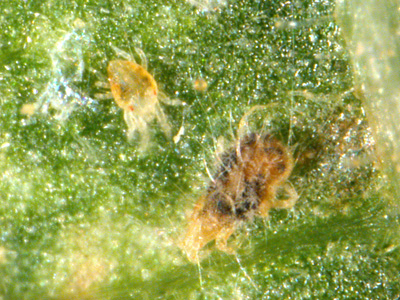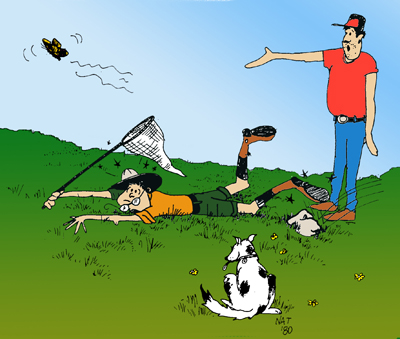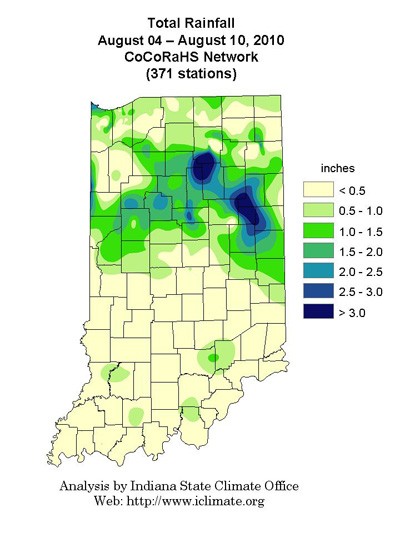Pest & Crop Newsletter, Entomology Extension, Purdue University
Yellow Butterflies Plentiful - (Christian Krupke and John Obermeyer)
- Alfalfa butterflies are pleasing to look at, not pests.
While driving through the countryside, many have been greeted with the pleasing sight of yellow butterflies on and along roadsides near puddles of water or wet surfaces. This is the alfalfa butterfly, Colias eurytheme, also known as “sulfurs.” These butterflies congregate in large numbers near sources of moisture and/or salt (puddles often leave salty deposits behind as they dry up). They are prevalent during mid-day, their peak mating time.
Soybean aphid colonized leaflet
Alfalfa caterpillar butterfly (“sulfur”) feeding on velvetleaf flower
The larvae of these butterflies are referred to as the alfalfa caterpillar. This caterpillar is up to 1-1/2 inches long, has a velvety-smooth lime-green body with a white stripe on each of its sides. This caterpillar is commonly found in alfalfa, clover, and vetch, but it can occasionally be found defoliating soybean leaves. Though the numbers of butterflies may be numerous, this does not indicate an outbreak of caterpillars is soon to follow. These caterpillars are very susceptible to insect diseases that can rapidly bring their numbers down to very low levels. When this happens, it is referred to as an epizootic. Therefore, enjoy this beautiful late summer butterfly before they disappear.
Alfalfa caterpillar feeding on leaves
![]()
Yellow Beans, Many Possibilities - (Christian Krupke and John Obermeyer)
- Many factors, some in combination, cause soybean plants to discolor.
- Scout to determine that spider mites are not the primary cause for yellowing.
While driving through different areas of the state it is amazing to see the number of soybean fields exhibiting areas of yellow.
A number of factors can cause leaf yellowing. These include, but not limited to, soybean cyst nematode, nutrient deficiencies, poor nodulation, herbicide injury, diseases such as sudden death syndrome, compaction, etc. Spider mites may be present along with any of these other plant stressors and may or may not be causing the discolored foliage. In other words, it’s the old chicken and egg dilemma. Stressed plants actually provide better nutrition for spider mites thus they thrive and quickly colonize areas or whole fields. The best spider mite control is to eliminate plant stress, and in the absence of timely rains, this is often easier said than done.
Before considering control, it is very important that spider mites be conclusively identified as the source of the problem. Shake some discolored soybean leaves over a white piece of paper. Watch for small dark specks moving about on the paper. Also look for very fine webbing on the undersides of the discolored leaves. Once spider mites have been positively identified in the damaged areas of the field, it is essential that the whole field be scouted to determine the range of infestation. Sample in at least five different areas of the field and determine whether the spider mites are present or not by using the “shake” method. Also look for the presence of diseased spider mites, darkened and shriveled mites. With the high humidity that we have experienced, fungal diseases can quickly spread throughout the population (epizootic). Some good news concerning our hot and muggy conditions!
Yellowed areas of a field...what is the problem?
Magnified view of a healthy and diseased spider mite
![]()
Click here to view the Black Light Trap Catch Report
Look Bug Scout -- It is much too pretty to be a corn borer. Do you think it could be an alfalfa butterfly?
![]()
Click here to view the Western Bean Cutworm Adult Pheromone Trap Report








